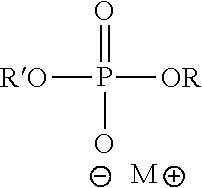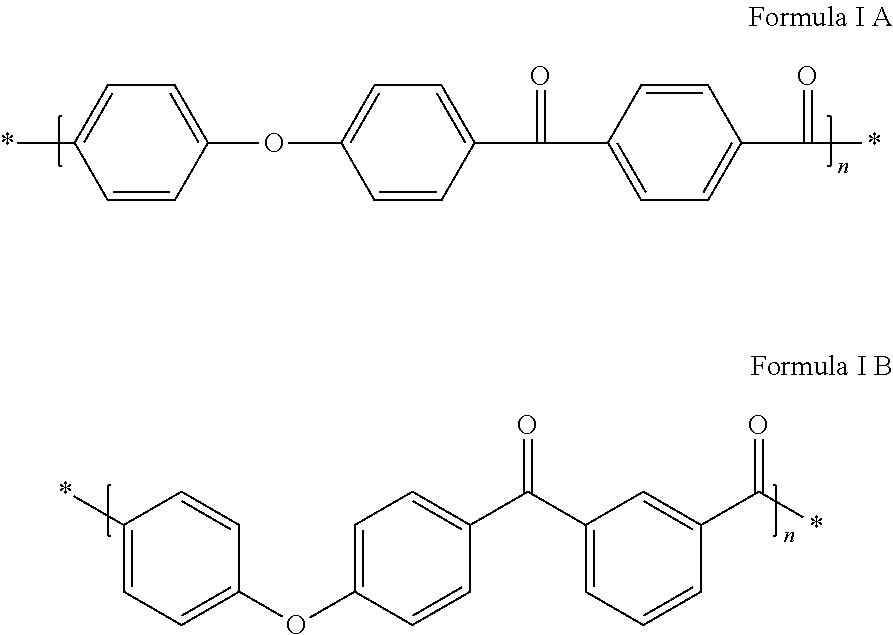Method for stabilising a composition made from poly(arylene-ether-ketone) (PAEK)
a technology of arylene ether and composition, applied in the field of poly(arylene ether ketone) composition stabilisation, can solve the problems of molten paeks that are not stable with regard, deterioration in the physicochemical and/or mechanical properties of paeks, and difficulty in processing these polymers in the molten sta
- Summary
- Abstract
- Description
- Claims
- Application Information
AI Technical Summary
Benefits of technology
Problems solved by technology
Method used
Image
Examples
example 1
nts of Viscosity Under Nitrogen
[0081]Several compositions based on PEKK were prepared. A control composition CT of PEKK comprising no stabilizer was prepared by a conventional synthesis process by a polycondensation reaction.
[0082]A second composition based on PEKK, with the reference C1, was prepared by wet impregnation, wherein PEP-Q (tetrakis(2,4-di-tert-butylphenyl) [1,1′-biphenyl]-4,4′-diyl bisphosphonite), of formula (1) below, was incorporated at an amount of 1000 ppm. This phosphonite is used as comparative example for stabilizing the PEKK composition.
[0083]A third composition based on PEKK, with the reference C2, was prepared by aqueous impregnation, wherein anhydrous monosodium phosphate (NaH2PO4), also referred to as sodium dihydrogen phosphate, of formula (2) below, was incorporated at an amount of 1000 ppm.
[0084]A fourth composition based on PEKK, with the reference C3, was prepared in the same manner as the second and third compositions, by aqueous impregnation, wherei...
example 2
nts of Viscosity Under Nitrogen and Under Air
[0092]Several compounds based on PEKK were prepared by the compounding technique. The different compounds are produced with an extruder from several compositions based on PEKK. The behavior of the different compositions at 380° C. under nitrogen and under air was compared.
[0093]A first control composition CT′ of PEKK in the form of granules and not comprising any stabilizer was prepared.
[0094]A second composition based on PEKK, with the reference C5, was prepared by the compounding technique, wherein monosodium phosphate (NaH2PO4), of formula (1) above, was incorporated at an amount of 1000 ppm.
[0095]A third composition based on PEKK, with the reference C6, was prepared by the compounding technique, wherein trisodium phosphate (Na3P3O9), of formula (3) above, was incorporated at an amount of 1000 ppm.
[0096]A fourth composition based on PEKK, with the reference C7, was prepared by the compounding technique, wherein ADK STAB NA-11UH (sodium...
example 3
of the Ratio of Phosphate Salt Incorporated
[0100]Several compositions based on PEKK were prepared. A control composition CT of PEKK comprising no stabilizer was prepared by a conventional synthesis process by a polycondensation reaction. The other compositions are based on PEKK and each comprise anhydrous trisodium phosphate at different contents.
[0101]The compositions compared are prepared by aqueous impregnation.
[0102]The composition with the reference C8 in table III below comprises 500 ppm of anhydrous trisodium phosphate, while the composition with the reference C9 comprises 1000 ppm thereof and the composition with the reference C10 comprises 3000 ppm thereof.
[0103]The melt viscosity of these compositions CT, C8, C9 and C10 was then measured with an oscillating rheometer as a function of time, at 380° C., under nitrogen, with a stress of 1 Hz and with a strain amplitude of 0.5%.
[0104]Table III below brings together the data on stability (EV %) under nitrogen of these different...
PUM
| Property | Measurement | Unit |
|---|---|---|
| temperatures | aaaaa | aaaaa |
| temperatures | aaaaa | aaaaa |
| temperatures | aaaaa | aaaaa |
Abstract
Description
Claims
Application Information
 Login to View More
Login to View More - R&D
- Intellectual Property
- Life Sciences
- Materials
- Tech Scout
- Unparalleled Data Quality
- Higher Quality Content
- 60% Fewer Hallucinations
Browse by: Latest US Patents, China's latest patents, Technical Efficacy Thesaurus, Application Domain, Technology Topic, Popular Technical Reports.
© 2025 PatSnap. All rights reserved.Legal|Privacy policy|Modern Slavery Act Transparency Statement|Sitemap|About US| Contact US: help@patsnap.com



